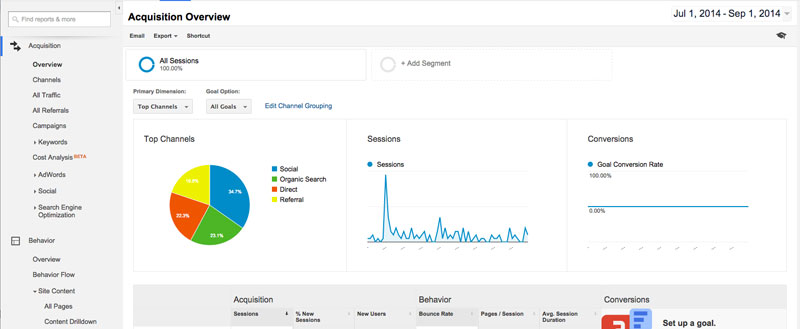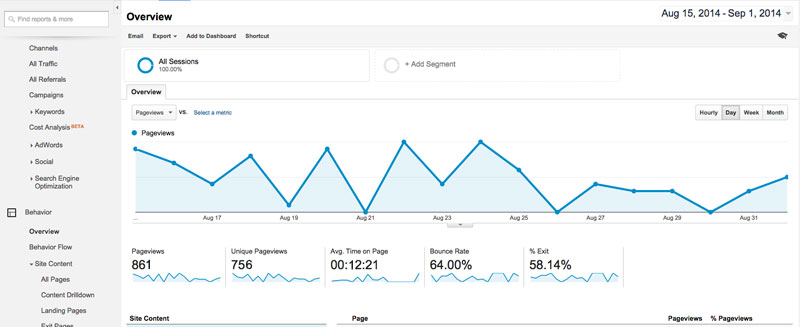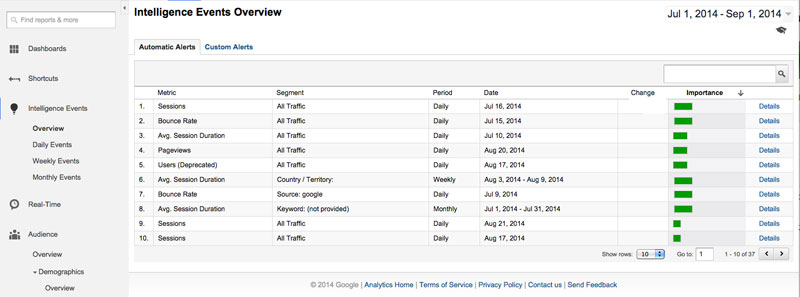BLOG
Beginners Guide to Google Analytics
With online performance being so critical to business growth and success, you have to be confident that your website is:
- Being found by your target market; and
- Nurturing these visitors effectively, once there.
But how do you know if what you have is attracting and engaging your current and potential customers?
Google Analytics. It’s not only completely free, but it offers you invaluable information about how your website is faring. Read on to find out how you can utilise this incredible tool.
Audience Overview
First off, when you enter the site, you’ll be shown the Visitors Overview. In the top section of the overview, there is a chart where you can see how much traffic you’ve been receiving over the past month. To see different periods of time and to see a comparison between two periods of time, you can use the dropdown menu in the top right corner of the screen.
A very useful function that you can use on this page is creating annotations. Doing so allows you to keep track of a certain day that might have had different traffic to usual. Whether you’ve had more or less visits than usual, you’ll be able to attribute to a cause.
To see a more detailed report of your visitors, you can click to find a main report on the left side of your screen. This detailed report also allows you to see the sources of your traffic, content, as well as how many conversions were made.

Visitors
The visitors overview screen shows you the number of visitors, unique visitors and page views. It also shows you how much time your visitors are spending on your site, the bounce rate and what percentage of your traffic is new. This in-depth information is very useful for gauging how well your site is going and how useful your visitors think your content is.
More specifically, this section gives you an idea of who your visitors are. By looking at some basic demographics you can learn everything from their gender to how old they are. Visitors can also be divided by language, country/territory, or city, as well as more technical aspects such as the browser they are using, who their service provider is, and whether they are on a desktop, tablet or mobile phone. Being able to pinpoint who exactly is visiting your site and how they are doing so gives you the unique opportunity to ensure that you are marketing to the right people, in the right way.
Location
For a more detailed view of your visitors’ demographics and actual locations, you can click the navigation on the page. In each of these separate pages you can look at specific information including maps that will show you what parts of the world and which particular parts of the country your visitors are coming from.
Frequency and Recency
Within the visitors section, there is also a report that tells you about the behaviour of your visitors. The behaviour of your visitors will change based on variables such as whether they are first-time visitors. This function gives you special insight into how many of your visitors are real fans by showing you how many times people are entering your site, as well as the last time they visited.
Engagement
In addition, you’ll be able to find out how engaged each of your visitors are when they enter your site. Visitors who have done so frequently and have spent a noticeably longer time on certain pages, or have been viewing more pages are also likely to be considered fans.
Technology and Mobile Statistics
Generally these two reports do not offer much in a marketing perspective. However, they do serve a good purpose. By keeping an eye on these reports, you’ll be able to pay attention to any trends that may pop up. If many of your visitors are using mobile devices to access your site, you know that you’ll need to invest some time into keeping your site functional and responsive.
Acquisition
The traffic sources overview gives you arguably the most valuable information on your digital marketing activity.. Outside of the content on your actual site, you’re spending time working on everything from SEO and incoming links to any social media advertising campaigns you may be running. This section will help you determine whether you have been successful in these efforts. Your traffic should preferably show an array of different sources.
This information will help you to figure out which areas you should be supplementing. If you have a particular source that continually directs traffic to your site, you will need to try and maintain it.

Keywords
A key source of your traffic comes from your organic search results, so it is important to know what particular keywords people are using to find your site. The keyword report gives you a list the most used keywords as well as every other keyword that has been used to find your site. Keep in mind here that Google doesn’t release all of the desired information.
A more detailed keyword report can be found in the ‘Search’ sub-report. This report shows you which page on your site is being landed on the most as well as which search engine has directed them. There are also other ways to look at your traffic, including your paid and organic traffic, and traffic that is specifically associated with certain campaigns you might be running.
AdWords
If you are using Google Analytics in conjunction with Google AdWords, you are open to an entirely separate section of information. The AdWords section offers you comprehensive reports regarding the traffic that has been driven by each of your different ads. This includes everything from destination URLs to keyword positions and TV ads.
It also shows you the results of each of these visits, including how many visits were driven, the average duration of time spent on the site, the bounce rate, the percentage of visits that are new, how many of your goals were completed, as well as how much revenue you were able to generate from each visit. Using this information, you’ll be able to gauge which ads are working for you and which you should reconsider.
Behaviour
The content overview page has a graph that depicts the amount of page views instead of the amount of visits. These are two separate and important values. The amount of page views is how many times a page has been loaded, including whether the page has been refreshed or whether the visitor has navigated to another page. On the other hand, a unique view is only counted when the site is visited during a new browsing session.

On this page, you are also able to look at information about the content of the site, based on its page or page title. There are also options to view statistics about your site search as well as your events, and how much you are earning through Adsense.
Exit pages
The exit page is the page that a visitor leaves your site from. Knowing which are the last pages being landed on will give you an idea of where you may need to add information or options to encourage more viewing.
Speed
Included also, is a report that allows you to check if any of your pages are loading at significantly slow speeds. This is very annoying for visitors and can cause them to leave the site.
Conversions
The most user-friendly category in the conversion section is the goals function. Goals are useful for keeping track of desired actions taken by visitors of your site. This can include things such as online sales, enquiry forms completions, newsletter signups and account creations. It is fairly easy to set up your goals. You simply have to select the goal group that you want to you, and then name and describe your goal.
Customisation
A very special benefit that Google Analytics offers is being able to form custom reports. You are able to control how these reports filter certain results as well as adding new content into the system to segment your reports even further.
Intelligence Events

Finally, there is the Intelligence Events section. This particular section offers quick and accurate information about changes to your site. Using this information, you can make decisions about how you can change your site to benefit your visitors.
The Intelligence section gives you the opportunity to create automatic alerts regarding your page views, visits, average time on site as well as other metrics. You can also customise the process by adding alerts for any other information you may need. This can include specific segments of traffic or for your goals.
In this digital age, customers are relying more heavily on the Internet and basing their decisions on how you represent yourself online. To give your business the best chance of success, you have to be tracking and analysing your website performance. Keep an eye on your Google Analytics, read the signs and show some agility!











